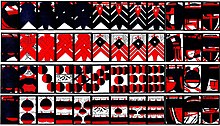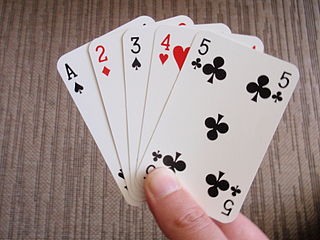
A playing card is a piece of specially prepared card stock, heavy paper, thin cardboard, plastic-coated paper, cotton-paper blend, or thin plastic that is marked with distinguishing motifs. Often the front (face) and back of each card has a finish to make handling easier. They are most commonly used for playing card games, and are also used in magic tricks, cardistry, card throwing, and card houses; cards may also be collected. Playing cards are typically palm-sized for convenient handling, and usually are sold together in a set as a deck of cards or pack of cards.

The tarot is a pack of playing cards, used from at least the mid-15th century in various parts of Europe to play card games such as Tarocchini. From their Italian roots, tarot playing cards spread to most of Europe evolving into a family of games that includes German Grosstarok and modern games such as French Tarot and Austrian Königrufen. In the late 18th century, French occultists made elaborate, but unsubstantiated, claims about their history and meaning, leading to the emergence of custom decks for use in divination via tarot card reading and cartomancy. Thus there are two distinct types of tarot pack in circulation today: those used for card games and those used for divination. However, some older patterns, such as the Tarot de Marseille, originally intended for playing card games, are occasionally used for cartomancy.

Karuta are Japanese playing cards. Playing cards were introduced to Japan by Portuguese traders during the mid-16th century. These early decks were used for trick-taking games. The earliest indigenous karuta was invented in the town of Miike in Chikugo Province at around the end of the 16th century. The Miike karuta Memorial Hall located in Ōmuta, Fukuoka, is the only municipal museum in Japan dedicated specifically to the history of karuta.

In playing cards, a suit is one of the categories into which the cards of a deck are divided. Most often, each card bears one of several pips (symbols) showing to which suit it belongs; the suit may alternatively or additionally be indicated by the color printed on the card. The rank for each card is determined by the number of pips on it, except on face cards. Ranking indicates which cards within a suit are better, higher or more valuable than others, whereas there is no order between the suits unless defined in the rules of a specific card game. In a single deck, there is exactly one card of any given rank in any given suit. A deck may include special cards that belong to no suit, often called jokers.
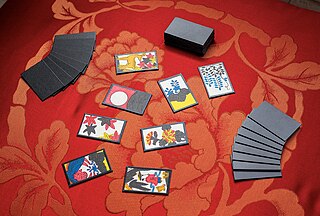
Hanafuda are a type of Japanese playing cards. They are typically smaller than Western playing cards, only 5.4 by 3.2 cm, but thicker and stiffer, and often with a pronounced curve. On the face of each card is a depiction of plants, tanzaku (短冊), animals, birds, or man-made objects. One single card depicts a human. The back side is usually plain, without a pattern or design of any kind, and traditionally coloured either red or black. Hanafuda are used to play a variety of games including Koi-Koi and Hachi-Hachi.

The king is a playing card with a picture of a king displayed on it. The king is usually the highest-ranking face card. In the French version of playing cards and tarot decks, the king immediately outranks the queen. In Italian and Spanish playing cards, the king immediately outranks the knight. In German and Swiss playing cards, the king immediately outranks the Ober. In some games, the king is the highest-ranked card; in others, the ace is higher. Aces began outranking kings around 1500 with Trappola being the earliest known game in which the aces were highest in all four suits. In the Ace-Ten family of games such as pinochle and schnapsen, both the ace and the 10 rank higher than the king.

The standard 52-card deck of French-suited playing cards is the most common pack of playing cards used today. In English-speaking countries it is the only traditional pack used for playing cards; in many countries of the world, however, it is used alongside other traditional, often older, standard packs with different suit systems such as those with German-, Italian-, Spanish- or Swiss suits. The most common pattern of French-suited cards worldwide and the only one commonly available in English-speaking countries is the English pattern pack. The second most common is the Belgian-Genoese pattern, designed in France, but whose use spread to Spain, Italy, the Ottoman Empire, the Balkans and much of North Africa and the Middle East. In addition to those, there are other major international and regional patterns including standard 52-card packs, for example, in Italy that use Italian-suited cards. In other regions, such as Spain and Switzerland, the traditional standard pack comprises 36, 40 or 48 cards.

Spanish-suited playing cards or Spanish-suited cards have four suits, and a deck is usually made up of 40 or 48 cards. It is categorized as a Latin-suited deck and has strong similarities with the Portuguese-suited deck, Italian-suited deck and some to the French deck. Spanish-suited cards are used in Spain, southern Italy, parts of France, Hispanic America, North Africa, and the Philippines.

Playing cards have been in Italy since the late 14th century. Until the mid 19th century, Italy was composed of many smaller independent states which led to the development of various regional patterns of playing cards; "Italian suited cards" normally only refer to cards originating from northeastern Italy around the former Republic of Venice, which are largely confined to northern Italy, parts of Switzerland, Dalmatia and southern Montenegro. Other parts of Italy traditionally use traditional local variants of Spanish suits, French suits or German suits.
Minchiate is an early 16th-century card game, originating in Florence, Italy. It is no longer widely played. Minchiate can also refer to the special deck of 97 playing cards used in the game. The deck is closely related to the tarot cards, but contains an expanded suit of trumps. The game was similar to but more complex than tarocchi. The minchiate represents a Florentine variant on the original game.

Trionfi are 15th-century Italian playing card trumps with allegorical content related to those used in tarocchi games. The general English expression "trump card" and the German "trumpfen" have developed from the Italian "Trionfi". Most cards feature the personification of a place or abstraction.
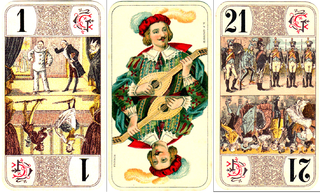
The Bourgeois Tarot deck is a mid-19th century pattern of tarot cards of German origin that is still used for playing card games today in western Europe and Canada. It is not designed for divinatory purposes. This deck is most commonly found in France, Belgian Wallonia, Swiss Romandy and Canadian Québec for playing French Tarot; in southwest Germany for playing Cego and Dreierles; and in Denmark for Danish Tarok.
The Tarocco Piemontese is a type of tarot deck of Italian origin. It is the most common tarot playing set in northern Italy, much more common than the Tarocco Bolognese. The most popular Piedmontese tarot games are Scarto, Mitigati, Chiamare il Re, and Partita which are played in Pinerolo and Turin. This deck is considered part of Piedmontese culture and appeared in the 2006 Winter Olympics closing ceremony held in Turin. As this was the standard tarot pack of the Kingdom of Sardinia, it was also formerly used in Savoy and Nice before their annexation by France. Additionally, it was used as an alternative to the Tarocco Siciliano in Calatafimi-Segesta, Sicily. Outside of Italy, it is used by a small number of players in Ticino, Switzerland and was used by Italian Argentines.

Tujeon are the traditional playing cards of Korea used in the latter half of the Joseon dynasty. They are also known as tupae.

Parts of Swiss German speaking Switzerland have their own deck of playing cards referred to as Swiss-suited playing cards or Swiss-suited cards. They are mostly used for Jass, the "national card game" of Switzerland. The deck is related to the various German playing cards. Within Switzerland, these decks are called German or Swiss German cards.

German-suited playing cards are a very common style of traditional playing card used in many parts of Central Europe characterised by 32- or 36-card packs with the suits of Acorns, Leaves, Hearts and Bells. The German suit system is one of the oldest, becoming standard around 1450 and, a few decades later, influencing the design of the now international French suit system of Clubs, Spades, Hearts and Diamonds. Today German-suited playing cards are common in south and east Germany, Austria, German-speaking Switzerland, Liechtenstein, north Italy, Hungary, Czech Republic, Slovakia, Slovenia, Croatia, Bosnia, northern Serbia, southern Poland and central and western Romania.
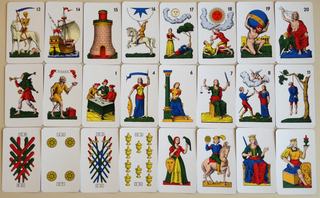
The Tarocco Siciliano is a tarot deck found in Sicily and is used to play Sicilian tarocchi. It is one of the three traditional Latin-suited tarot decks still used for games in Italy, the others being the more prevalent Tarocco Piemontese and the Tarocco Bolognese. The deck was heavily influenced by the Tarocco Bolognese and the Minchiate. It is also the only surviving tarot deck to use the Portuguese variation of the Latin suits of cups, coins, swords, and clubs which died out in the late 19th and early 20th centuries.

French-suited playing cards or French-suited cards are cards that use the French suits of trèfles, carreaux, cœurs, and piques. Each suit contains three or four face/court cards. In a standard 52-card deck these are the valet, the dame, and the roi (king). In addition, in Tarot packs, there is a cavalier (cavalier) ranking between the queen and the jack. Aside from these aspects, decks can include a wide variety of regional and national patterns, which often have different deck sizes. In comparison to Spanish, Italian, German, and Swiss playing cards, French cards are the most widespread due to the geopolitical, commercial, and cultural influence of France, the United Kingdom, and the United States in the 19th and 20th centuries. Other reasons for their popularity were the simplicity of the suit insignia, which simplifies mass production, and the popularity of whist and contract bridge. The English pattern of French-suited cards is so widespread that it is also known as the International or Anglo-American pattern.
Five-suit bridge is a late 1930s variation of contract bridge played with a deck of 65 playing cards divided into five suits.






